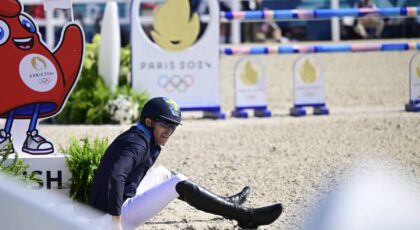We all know that while in the saddle, the rider communicates with the horse using a language of succinct signals. Oh, yeah…and these signals are called aids.
Since the aids are what allow you to communicate with your mount, it is important to get them right. Problem is, many of us DON’T, which leads to confusion on our horse’s part and perhaps frustration on ours. To keep things copacetic to horse and rider, there are specific considerations to keep in mind. Here are Julia Kohl’s 7 Rules for getting riding aids right from her bestselling book Creative Dressage Schooling:
***
1. Use a friendly “tone”
You wouldn’t appreciate being rudely accosted during a normal, everyday conversation with another person. The dialogue between horse and rider should be just as soft and respectful. Of course, the rider may need to make her point clearly when there is a disagreement, but afterward it is important to return to a positive tone.

photo by Daniela Derler
2. Note when discipline is necessary
When your horse won’t do something that you know he can do, or when he is simply not paying attention and doesn’t react, appropriate and timely discipline may be in order. This does not mean brutal application of the whip or yanking on the reins. A very clearly given aid can be enough of a disciplinary action. Check that your correction was effective by testing the horse—ask him to respond to a “normal” aid again.
3. Don’t give endless aids
Imagine what it is like when your conversation partner blabbers at you endlessly about trivial matters. Eventually your brain “shuts off” and you tune him or her out. This happens with horses, as well. If you give constant, monotone, repetitive aids, your horse will become desensitized to them and no longer “hear” you. Thus, it is important to ride with aids applied with logical timing and meaning.

photo by Daniela Derler
4. Cultivate reactions to subtle aids
Do you feel like you need an oxygen mask after your warm-up because your horse won’t travel for even a few strides by himself and without you ”pushing” or “carrying” him along? This problem must be addressed and can’t be solved just by riding around and around the arena. The horse must be taught to respond immediately to your aids. For example, only use a light, brief leg aid on your horse. If the horse ignores it, repeat the aid with the same intensity. Do not defer to a longer, stronger squeeze. If reinforcement is necessary, use the spur or the whip right behind the calf, or on the horse’s shoulder. Do not hold your horse back with the reins when making this correction, even if he is likely to react explosively—a “wake up” is the desired effect!

photo by Daniela Derler
5. Understand the absence of aids as a reward
Just as an exaggerated or repeated aid is in some ways a kind of punishment for your horse, the absence of aids is a kind of reward. Become passive between aids to maintain your horse’s relaxed and happy attitude.

photo by Daniela Derler
6. Avoid excessive use of strength when giving aids
Firstly, riding with such overt use of strength does not look good, and secondly, exaggerated use of strength is usually accompanied by muscle tension, which makes a relaxed and supple seat impossible. This has a negative influence on your horse’s own suppleness and movement.
7. Obedience is still key
Although we strive for harmony between horse and rider, in the end the horse must be obedient to the rider when under saddle. This can be compared to what it is like to raise a young child: When the child whines and disobeys, it is important that the parent has the last word. Then the child learns to see the parent as a consistent authority figure and accepts his or her guidance.
***
This excerpt from Creative Dressage Schooling by Julia Kohl is reprinted with permission from Trafalgar Square Books.




 January 2, 2018
January 2, 2018 





























